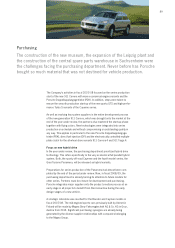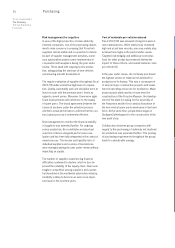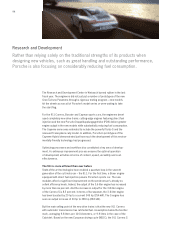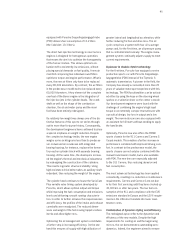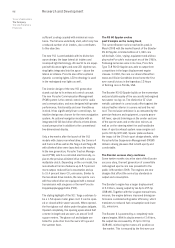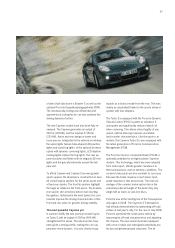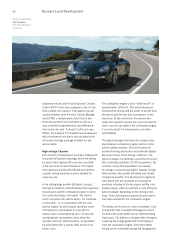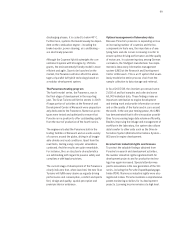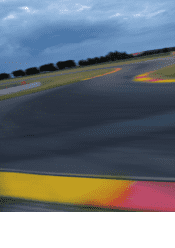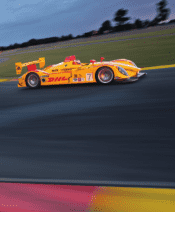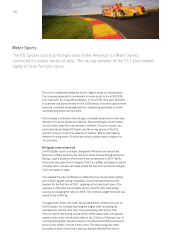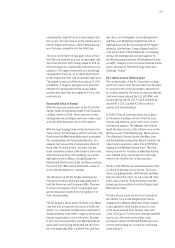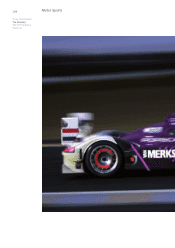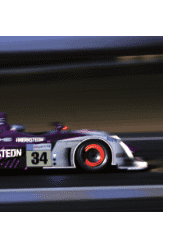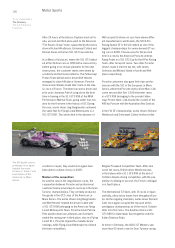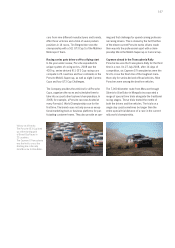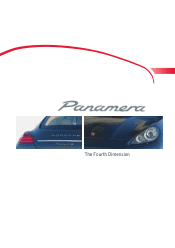Porsche 2007 Annual Report Download - page 102
Download and view the complete annual report
Please find page 102 of the 2007 Porsche annual report below. You can navigate through the pages in the report by either clicking on the pages listed below, or by using the keyword search tool below to find specific information within the annual report.discharging phases, it is cooled to below 40°C.
Furthermore, systems that would usually be depen-
dent on the combustion engine – including the
brake booster, power steering, air conditioning –
are electrically powered.
Although the Cayenne Hybrid outweighs the con-
ventional Cayenne with V6 engine by 150 kilo-
grams, the environmentally friendly model is more
efficient and agile. Soon to be launched on the
market, the Panamera will also afford the advan-
tages of parallel full hybrid technology based on
a modular development system.
The Panamera testing program
The fourth model series, the Panamera, was in
the final stage of development in the reporting
year. The Gran Turismo will hit the streets in 2009.
A large portion of activities at the Research and
Development Center in Weissach were unquestion-
ably dedicated to the Panamera. Numerous proto-
types were tested and optimized to ensure that
Porsche is in a position to offer outstanding quality
from the start of production of the fourth series.
The engineers tested the Panamera both in the
testing facilities in Weissach and on a wide variety
of courses around the globe, driving in all imagin-
able climate and road conditions. Apart from the
road tests, testing using computer simulations
continued. And the results are quite remarkable.
For instance, the car structure’s characteristics
are outstanding with regard to passive safety and
compliance with legal provisions.
The current stage of development of the Panamera
clearly indicates that, when launched, the new Gran
Turismo will fulfill every desire as regards driving
performance and consumption, comfort and sports
feel, design and quality, spatial perception and
premium interior ambiance.
Optimal management of laboratory data
Because Porsche’s presence is expanding across
an increasing number of countries and the bio-
components in fuels vary, the importance of ana-
lyzing fuels and oils is ever increasing in order to
ensure optimal driving performance and the quality
of motorcars. In a pioneering step among German
carmakers, the Stuttgart manufacturer has imple-
mented a laboratory information management
system (LIMS) at the Research and Development
Center in Weissach. This is an IT system that seam-
lessly models the entire process chain from the
sample collection to data storage and retrieval.
In fiscal 2007/08, the chemists processed some
2,600 oil and fuel samples and collected some
60,000 individual data. These findings make an
important contribution to engine development
and testing work and provide information on wear
and on the quality of the fuels used in cars around
the world. In the one-year testing phase, the LIMS
has demonstrated that it offers innovative possibi-
lities for processing large data volumes efficiently.
Besides improving the linkage and management of
workflow in the laboratory, the system also allows
data transfer to other units such as the Drive In-
formation System (Antriebs-Informations System –
AIS) used in engine development.
Income from industrial rights and licenses
To protect the valuable findings obtained from
Porsche’s research and development activities,
the number industrial rights registered both for
development projects and for production techno-
logy has again increased. Special attention was
paid to innovations in the new generation of the 911
series, including the Porsche Doppelkupplungsge-
triebe (PDK). Numerous industrial rights were also
registered in Asia. Porsche maintains comprehensive
patent monitoring activities for its development
projects. Licensing income remains at a high level.
99


